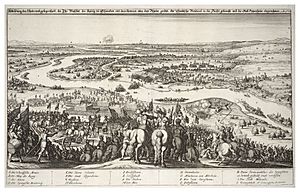Capture of Oppenheim facts for kids
Quick facts for kids Capture of Oppenheim |
|||||||
|---|---|---|---|---|---|---|---|
| Part of the Palatinate phase of the Thirty Years' War | |||||||
 The Capture of Oppenheim by Wenzel Hollar. |
|||||||
|
|||||||
| Belligerents | |||||||
| Commanders and leaders | |||||||
| Strength | |||||||
| 24,000 (Joachim Ernst) 1,000 (Oppenheim) |
22,000 | ||||||
| Casualties and losses | |||||||
| Few dead or wounded 800–1,000 captured |
Minor | ||||||
The Capture of Oppenheim was an important event during the Thirty Years' War. It happened on September 14, 1620, in a town called Oppenheim in what was then the Electoral Palatinate (now part of Germany). This battle was between the Spanish army, led by Don Ambrosio Spinola, and the forces from the Electoral Palatinate, led by Joachim Ernst, Margrave of Brandenburg-Ansbach. Spinola's Spanish troops used a clever trick to make the Protestant army move away. This allowed them to capture Oppenheim quite easily. This victory was a big win for the Spanish and a tough loss for the Protestant forces.
Why Oppenheim Was Important
In 1620, the Spanish Monarchy joined the Thirty Years' War. Their goal was to take control of the Electoral Palatinate. This area was very important to Spain. It was on the "Spanish Road," a key route for moving soldiers and supplies from Italy to the Spanish Netherlands. Also, Spain was a Catholic country. They wanted to support the Holy Roman Emperor against the Protestant groups in the war.
In August 1620, Don Ambrosio Spinola, who was the main commander of the Army of Flanders (the Spanish army in the Netherlands), marched into the Palatinate. He first went towards Frankfurt. But the Protestants quickly sent more soldiers to Frankfurt, so Spinola decided not to attack there. Instead, he turned his army towards Oppenheim. Before reaching Oppenheim, his troops captured the towns of Bad Kreuznach and Alsheim in early September.
Spinola's main goal was to capture a good-sized city. This city would help him get supplies and ammunition for his army. It would also give his soldiers a safe place before winter arrived. Oppenheim was perfect for this. It was a very important town because its bridge controlled the way into the main part of the Palatinate. However, Oppenheim had strong walls and many soldiers defending it. Attacking it directly seemed too risky.
How Oppenheim Was Captured
Spinola moved his army from Alsheim. He then did a smart trick to fool the Protestant army. He made it look like his army was marching towards Worms. This was meant to distract the Protestant forces.
Joachim Ernst, Margrave of Brandenburg-Ansbach was in charge of the Protestant army. He had about 24,000 soldiers stationed in and around Oppenheim. He fell for Spinola's trick. Joachim Ernst took most of his soldiers and marched to Worms. This left only a small group of soldiers to defend Oppenheim.
Spinola then took advantage of the night. He quickly moved his army towards Oppenheim. They arrived at dawn on September 14. The attack on the town's defenses began soon after.
The Protestant soldiers defending Oppenheim saw the huge Spanish army. They quickly left their defenses and surrendered. Only a few of them were killed or hurt by the attackers. Spinola's letters say that the Protestant defense force had about 800 strong musketeers (soldiers who used muskets) from the Palatinate. Oppenheim was captured. The Protestant soldiers were disarmed and then set free. The Spanish also took several flags and the Protestant soldiers' belongings from the town's barracks.
What Happened Next
Losing Oppenheim was a big problem for the Palatinate. The town was key to controlling the Rhine river. Its bridge was the main way into the heart of the Palatinate. The bridge had been destroyed during the fighting. Spinola ordered it to be rebuilt right away. He also told his soldiers to make the town's defenses stronger. He set up his main supply point there.
Spinola had left soldiers in other captured towns. This meant his main army was smaller. So, he decided to keep his army in Oppenheim for the winter. He also asked for more soldiers from Archduke Albert in Brussels.
On September 25, the main officers of the Spanish army held a meeting. That day, they learned that the Protestant cavalry (soldiers on horseback) were planning to attack their camp. Spinola sent Count Hendrik van den Bergh with 2,200 cavalry and some cannons to set up an ambush. But the fight never happened.
As winter began, both armies went back to their safe camps. By this time, the Protestants had received more soldiers from England, led by Sir Horace Vere. Over the next six months, the Spanish captured more than 30 towns and castles in the Lower Palatinate region.
See also
 In Spanish: Toma de Oppenheim para niños
In Spanish: Toma de Oppenheim para niños




